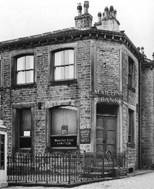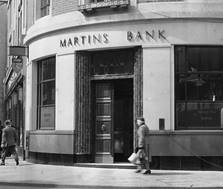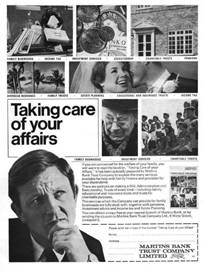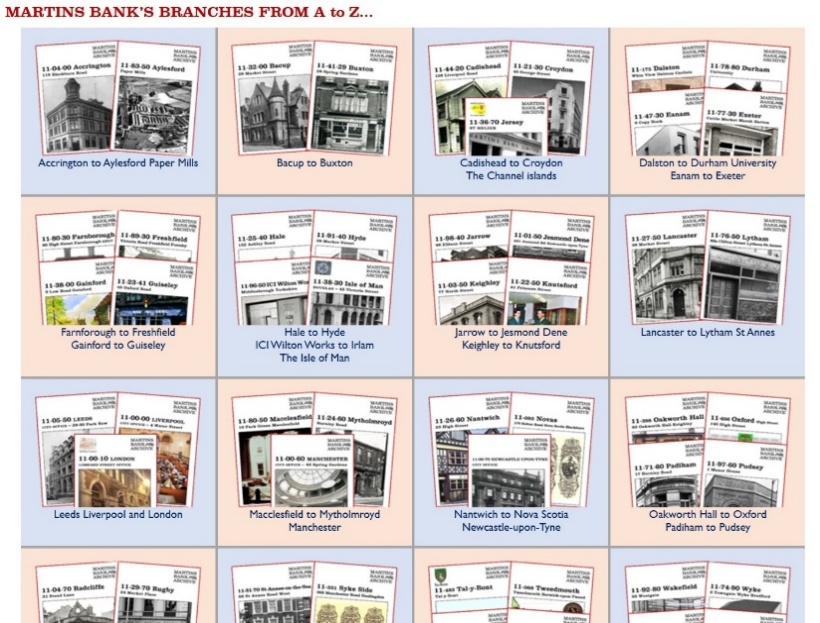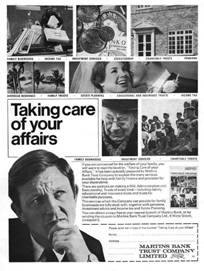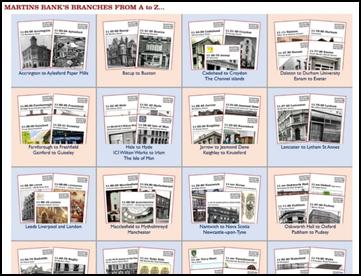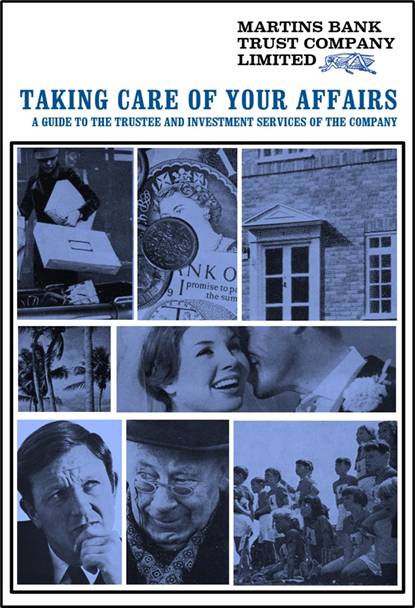|
  WELCOME to Martins Bank
Archive, and to MARTINS
BANK MAGAZINE -
our news feature in honour of the Bank’s staff publication, which from 1946
to 1969 brought news of changing times, new Branches and services and even
new technologies to those working in branches and departments in England
Wales, the Channel Islands and the Isle of Man. From Drive-In Branches to
computers and the Cash Dispenser, it seems that Martins Bank has it all,
yet on 1 November 1968, it becomes just one more of the Barclays Group of
Companies. This status is maintained only until close of Business on Friday
12 December 1969, as from the following Monday, 730 branches of the bank
will open their doors under the name of Barclays. WELCOME to Martins Bank
Archive, and to MARTINS
BANK MAGAZINE -
our news feature in honour of the Bank’s staff publication, which from 1946
to 1969 brought news of changing times, new Branches and services and even
new technologies to those working in branches and departments in England
Wales, the Channel Islands and the Isle of Man. From Drive-In Branches to
computers and the Cash Dispenser, it seems that Martins Bank has it all,
yet on 1 November 1968, it becomes just one more of the Barclays Group of
Companies. This status is maintained only until close of Business on Friday
12 December 1969, as from the following Monday, 730 branches of the bank
will open their doors under the name of Barclays.

Our final colour offering…

We stated in
October, that has never been our intention to spoil or change any of
Martins Bank’s original advertising copy.
We do our best to clean up images for presentation within our web
site, and we restore images as faithfully as we can. Artificial
intelligence allows us to this, but it also presents us with the dilemma of
when, if at all, it is right to colour an image that was only ever seen in
monochrome. This month we have the
final selection of images that we have used Artificial Intelligence to
colour in – knowing that Martins always wanted to be FIRST with a range of
services and technologies! The
bowler-hatter men make up the four corners of our cover picture, and the
Martinplanning couple look transformed by colour in their exchange of
Christmas gifts. The little boy who
writes a Kiddicraft® miniature cheque to his mummy for a bag of chocolate
coins is followed by the Head Office Christmas greeting to the staff from
1967, and the staff restaurant at head office laid out for Christmas Dinner
1959. The “counting-up” girl is seen
waving her wad of one-pound notes.
Although the bottom middle image is from the Queen’s Coronation in
1953, it was used on the Bank’s Christmas card that year, as the procession
was pictured going past Whitehall Branch.


Life after Martins…
Sometimes,
there IS life after banking. The
Martins Staff database is full of examples of men and women who went on to
bigger, and sometimes better things after leaving the service of the Bank. Often, members of the various operatic
and dramatic societies come to the fore.
Sometimes, a manager retires and then spends almost as long as their
career doing good in the local community.
Fame and fortune beckons also beckons for some of our staff. Last month we brought you the story of
Dorothy “Dotty” Wayne, and this month she is joined by a few more of the
people for whom life came AFTER Martins Bank…

G COLIN
CROMPTON

 Our good
friends at Talking Pictures TV currently have available to watch, a few
episodes of "The Wheeltappers and Shunters Social Club" - a
Granada Television variety show which ran for a few years in the mid-1970s. Our good
friends at Talking Pictures TV currently have available to watch, a few
episodes of "The Wheeltappers and Shunters Social Club" - a
Granada Television variety show which ran for a few years in the mid-1970s.
The show featured Colin Crompton as the curmudgeonly chairman, who would
sit ringing a very loud bell interrupting the acts and the audience with
witty one-liners. Colin broke into the entertainment world after an earlier
career with Martins Bank. He started at Manchester City office in 1946, and
he left Martins in 1954, having worked at Hightown, Besses o' th' Barn, Old
Trafford, and Miles Platting branches. Colin took to the part of the
Chairman of Wheeltappers' social committee with relish, and although fifty
years later the show is inappropriate in so many ways for today's
audiences, his humour was at least dry and witty, a refreshing change from
the misogyny and racism of many comedians of that time. His brother Neil,
known for his own variety of humour, also worked for the Bank, but made it
to a lower managerial role, staying on through the merger of Martins and
Barclays in 1969.

RENÉE FORDER

 It seems
that being a first-class secretary, and an extremely good actress paid
dividends for her, as her life after Martins shows. Renée resigned from
Martins Bank Southall Branch upon marriage in 1955, but was soon attracted
back to the world of work – and how!
Her love of the stage goes right back to the second world war. Her
original name was Irene Winifred Starbuck, and she was educated at Hackney
Central School. In the 1940s she was a member of the concert group “The
Joey Boys”, and she worked on a production of “The Vagabond King”. In 1948
she sang soprano at the Staff Dinner of Martins Bank’s London Foreign
Branch, and went on to appear in a total seven of the Cicala Players’
productions. Renée is pictured here in here favourite role as the troubled
nun Sister Bonaventure in the Cicala Players’ 1953 dramatic offering of the
same name at London’s Fortune Theatre.
In 1958 she became Secretary to the Vice-president of Crocker Anglo
Bank in San Francisco, moving to the Los Angeles Office in 1960. She returned to the United Kingdom in
1961, taking a secretarial role at the National Provincial Bank in London’s
Regent Street. Within two years she
became Secretary to the Vice-president of Bank of America (London), and by
1967 she was the Personal Secretary to the Deputy Chairman Lazard Brothers
& Co in London. Not content with
a life spent very much at the top of secretarial work, she continued with
her love of amateur opera and drama. A former member of the Ruislip
Operatic Society, she was a founder member and later Secretary of the
Harrow Light Opera Company. It seems
that being a first-class secretary, and an extremely good actress paid
dividends for her, as her life after Martins shows. Renée resigned from
Martins Bank Southall Branch upon marriage in 1955, but was soon attracted
back to the world of work – and how!
Her love of the stage goes right back to the second world war. Her
original name was Irene Winifred Starbuck, and she was educated at Hackney
Central School. In the 1940s she was a member of the concert group “The
Joey Boys”, and she worked on a production of “The Vagabond King”. In 1948
she sang soprano at the Staff Dinner of Martins Bank’s London Foreign
Branch, and went on to appear in a total seven of the Cicala Players’
productions. Renée is pictured here in here favourite role as the troubled
nun Sister Bonaventure in the Cicala Players’ 1953 dramatic offering of the
same name at London’s Fortune Theatre.
In 1958 she became Secretary to the Vice-president of Crocker Anglo
Bank in San Francisco, moving to the Los Angeles Office in 1960. She returned to the United Kingdom in
1961, taking a secretarial role at the National Provincial Bank in London’s
Regent Street. Within two years she
became Secretary to the Vice-president of Bank of America (London), and by
1967 she was the Personal Secretary to the Deputy Chairman Lazard Brothers
& Co in London. Not content with
a life spent very much at the top of secretarial work, she continued with
her love of amateur opera and drama. A former member of the Ruislip
Operatic Society, she was a founder member and later Secretary of the
Harrow Light Opera Company.

BERT
BROWNBILL

 It seems the
call of the footlights and later the TV cameras can be intoxicating, and
lead – in the case of Bert Brownbill – to a very long career in the world
of entertainment. Bill joined the
staff of Liverpool Heywoods Branch in 1916.
He appeared in Martins Bank Society of the Arts’ production of
“Merrie England” in 1946, left the Bank the same year, and never looked
back. In 1951 he achieved top billing in a West End Show and played the
part of Ginkle in White Horse Inn.
In 1955 he was on television in an episode of Dixon of Dock Green,
and from that point onwards the TV appearances just kept on coming: It seems the
call of the footlights and later the TV cameras can be intoxicating, and
lead – in the case of Bert Brownbill – to a very long career in the world
of entertainment. Bill joined the
staff of Liverpool Heywoods Branch in 1916.
He appeared in Martins Bank Society of the Arts’ production of
“Merrie England” in 1946, left the Bank the same year, and never looked
back. In 1951 he achieved top billing in a West End Show and played the
part of Ginkle in White Horse Inn.
In 1955 he was on television in an episode of Dixon of Dock Green,
and from that point onwards the TV appearances just kept on coming:

|
1956
“Keep It Clean”
|
1962
“Z Cars”
|
1964
“Crossroads: Kings Oak”
|
1965
“The Newcomers”
|
1969
“Happy Ever After”
|
|
|
1959
“No Hiding Place”
|
1963
“That's My Boy”
|
1964
“Boyd Q.C.”
|
1967
“Honey Lane”
|
1969
“Detective”
|
|
|
1959
“Blackpool Show Parade”
|
1963
“The Sentimental Agent”
|
1965
“The Troubleshooters”
|
1969
“On the Rocks”
|
1970
“Bachelor Father”
|
|
Bert died at Gorleston on Sea near Great
Yarmouth, Norfolk in 1982, at the age of 81 years.

DOROTHY
WAYNE
From the end of the second World War, until the early 2000s, it was
quite normal for someone to set out on a career path that  led them all the way to retirement. For many of us even in the 1980s
and 90s, movement from one job to another was seen as detrimental to your
CV, whereas the twenty-first century is all about gaining experience
wherever and whenever you can. The
Martins Bank Staff Database reveals a number of staff, for whom British
branch banking just wasn’t what they wanted. Many went to banks and financial
institutions abroad, others changed direction completely, many of these
following their beliefs in roles within the church. A few used their talents to break into
the worlds of writing, performing or writing music, even careers in
entertainment on radion and television.
Meet Dorothy (“Dotty”) Wayne (pictured, right), who left Harrogate
Grammar School in 1954 to beome a typist at Martins Bank in Harrogate. Within three years, her talents for
singing, whistling, guitar playing, and as a comedian got her noticed, and
she began an astonishingly full career in the world on entertainment. Spotted by impressario Greatrex Newman,
Dorothy joined his “fol-di-rols” performing group, and toured the resorts
of Britain, as well as performing at the famous Windmill Theatre in London.
By the 1960s, she had appeared as a regular guest on The David Nixon Show
on ITV, from ABC Weekend TV’s Didsbury Studios in Manchester, home of
Opportunity Knocks. She went on to
tour the world, working on Cunard Cruise Ships as an entertainter. There
are then countless appearances on Radio and Television, including as host
of a weekly record request spot on the BBC Light Programme. In addition she
was regularly asked to perform in or host variety specials on BBC TV or
Radio. In 1974 she played a
character in an episode of “Are you Being Served”. Undoubtedly a canny
person, Dotty was her own agent, able to pick and choose from what seemed
like a never ending flood of bookings. led them all the way to retirement. For many of us even in the 1980s
and 90s, movement from one job to another was seen as detrimental to your
CV, whereas the twenty-first century is all about gaining experience
wherever and whenever you can. The
Martins Bank Staff Database reveals a number of staff, for whom British
branch banking just wasn’t what they wanted. Many went to banks and financial
institutions abroad, others changed direction completely, many of these
following their beliefs in roles within the church. A few used their talents to break into
the worlds of writing, performing or writing music, even careers in
entertainment on radion and television.
Meet Dorothy (“Dotty”) Wayne (pictured, right), who left Harrogate
Grammar School in 1954 to beome a typist at Martins Bank in Harrogate. Within three years, her talents for
singing, whistling, guitar playing, and as a comedian got her noticed, and
she began an astonishingly full career in the world on entertainment. Spotted by impressario Greatrex Newman,
Dorothy joined his “fol-di-rols” performing group, and toured the resorts
of Britain, as well as performing at the famous Windmill Theatre in London.
By the 1960s, she had appeared as a regular guest on The David Nixon Show
on ITV, from ABC Weekend TV’s Didsbury Studios in Manchester, home of
Opportunity Knocks. She went on to
tour the world, working on Cunard Cruise Ships as an entertainter. There
are then countless appearances on Radio and Television, including as host
of a weekly record request spot on the BBC Light Programme. In addition she
was regularly asked to perform in or host variety specials on BBC TV or
Radio. In 1974 she played a
character in an episode of “Are you Being Served”. Undoubtedly a canny
person, Dotty was her own agent, able to pick and choose from what seemed
like a never ending flood of bookings.


All is safely gathered in…
 Autumn means it’s time to
gather in the harvest, and with the climate of the twenty-first century,
Autumn now seem to begin weeks before many of the crops and produce have
been taken out of the ground or from the bushes and trees! SEVENTY years ago, a little booklet
appeared on the counters of Martins Bank’s Branches. Entitled “Finance for Farmers”, it went
on – as Finance for Farmers AND GROWERS – to be one of the most widely read banking publications in England
and Wales. Autumn means it’s time to
gather in the harvest, and with the climate of the twenty-first century,
Autumn now seem to begin weeks before many of the crops and produce have
been taken out of the ground or from the bushes and trees! SEVENTY years ago, a little booklet
appeared on the counters of Martins Bank’s Branches. Entitled “Finance for Farmers”, it went
on – as Finance for Farmers AND GROWERS – to be one of the most widely read banking publications in England
and Wales.

 The brainchild of Raymond Creer (seen here as Manager of Southport’s
Ainsdale Branch, serving his mother at the counter), it was packed with
facts and figures put together from a formidable amount of research. It included handy references to
government rules and regulations for farmers and growers, and a wealth of
tips and tricks, not least details of loans, overdrafts and other financial
services available to the farming world. The brainchild of Raymond Creer (seen here as Manager of Southport’s
Ainsdale Branch, serving his mother at the counter), it was packed with
facts and figures put together from a formidable amount of research. It included handy references to
government rules and regulations for farmers and growers, and a wealth of
tips and tricks, not least details of loans, overdrafts and other financial
services available to the farming world.

Much of this information was put together by Ray, and the staff of
Martins  Bank’s Information and Advertising Department, which in 1963 saw it’s
first female member of the Bank’s staff to receive a managerial
appointment, the amazing and dearly missed friend of our Archive, Beryl
Creer – Beryl Evans as she was then.
The booklet evolved, increased in its number of pages, and became
known as FINANCE FOR FARMERS AND GROWERS – a title that Barclays continued to produce each year after the
merger until the late 1980s. Bank’s Information and Advertising Department, which in 1963 saw it’s
first female member of the Bank’s staff to receive a managerial
appointment, the amazing and dearly missed friend of our Archive, Beryl
Creer – Beryl Evans as she was then.
The booklet evolved, increased in its number of pages, and became
known as FINANCE FOR FARMERS AND GROWERS – a title that Barclays continued to produce each year after the
merger until the late 1980s.
 This makes the booklet perhaps the longest post-merger link between
Martins and Barclays, as the Companies Act of 1980 – when the familiar
“PLC” appeared after the names of companies – the Martins Branch Logo, was
finally removed from the Barclays stationery of former Martins
Customers. Beryl and Ray were both
great assets to the name of Martins, with Beryl at the helm of advertising
campaigns that include the zoo animals accompanying their owners to the
bank which sparked a national newspaper to send an elephant into York
Branch to see just how unfazed the staff would be! You can read more by
clicking the following links for AGRICULTURAL BANKING
and ADVERTISING
THE 1960s. This makes the booklet perhaps the longest post-merger link between
Martins and Barclays, as the Companies Act of 1980 – when the familiar
“PLC” appeared after the names of companies – the Martins Branch Logo, was
finally removed from the Barclays stationery of former Martins
Customers. Beryl and Ray were both
great assets to the name of Martins, with Beryl at the helm of advertising
campaigns that include the zoo animals accompanying their owners to the
bank which sparked a national newspaper to send an elephant into York
Branch to see just how unfazed the staff would be! You can read more by
clicking the following links for AGRICULTURAL BANKING
and ADVERTISING
THE 1960s.

Summertime on the road…
 In what must have been a highlight in the annual calendar of many
staff at Martins, the Bank’s fleet of six Mobile Branches is out on the
road throughout the Summer months.
Our front page for July illustrates a selection of events at which
visitors could bank, Managers could “network”, and teams of two spent weeks
on the road, staying between one and five nights in a local hotel. Start with trade stands in the 1930s, and
the introduction of Mobile Branch Caravans in 1948, these forms of banking
were a fixture of agricultural shows right up to the 1990s. You could find a Martins Mobile Bank or
Trade Stand at Scout Jamborees, Dog Shows, even major international shows
like The Boat Show and The Ideal Home Exhibition. The mobile branches were also used as
temporary branches in areas where the Bank was due to open for business in
a permanent site. They were vital
service on two post-war Liverpool Housing Estates, where houses had been
built, but where shops churches schools or banks were yet to be
placed. Trade stands became more and
more elaborate, with Martins transporting an entire two storey
pre-fabricated building to shows all over Great Britain. Our MOBILE BRANCHES, OUT
AND ABOUT and TRADE
STANDS sections are rich with images and memories of these
times, and include the Archive’s Graham Nicholls Collection - 35mm
colour slides which really bring the past back to life. In what must have been a highlight in the annual calendar of many
staff at Martins, the Bank’s fleet of six Mobile Branches is out on the
road throughout the Summer months.
Our front page for July illustrates a selection of events at which
visitors could bank, Managers could “network”, and teams of two spent weeks
on the road, staying between one and five nights in a local hotel. Start with trade stands in the 1930s, and
the introduction of Mobile Branch Caravans in 1948, these forms of banking
were a fixture of agricultural shows right up to the 1990s. You could find a Martins Mobile Bank or
Trade Stand at Scout Jamborees, Dog Shows, even major international shows
like The Boat Show and The Ideal Home Exhibition. The mobile branches were also used as
temporary branches in areas where the Bank was due to open for business in
a permanent site. They were vital
service on two post-war Liverpool Housing Estates, where houses had been
built, but where shops churches schools or banks were yet to be
placed. Trade stands became more and
more elaborate, with Martins transporting an entire two storey
pre-fabricated building to shows all over Great Britain. Our MOBILE BRANCHES, OUT
AND ABOUT and TRADE
STANDS sections are rich with images and memories of these
times, and include the Archive’s Graham Nicholls Collection - 35mm
colour slides which really bring the past back to life.


Important News
about the Martins Bank Staff Database

 We would like to draw your attention to the completion of the first
major phase of the Martins Bank Staff Database. The career details of more than 25,000
member of the Staff of martins Bank Limited, have been put together from
the information published by Martins Bank in its magazine and other
publications, and this has been in the public domain for at least
fifty-five years. It is vital that surviving members of Martins Bank’s
staff have the opportunity to see the career details held for them, and to
understand about how and why the database exists as a social history
resource that seeks to preserve the name of Martins Bank for the interest
of future generations. We would like to draw your attention to the completion of the first
major phase of the Martins Bank Staff Database. The career details of more than 25,000
member of the Staff of martins Bank Limited, have been put together from
the information published by Martins Bank in its magazine and other
publications, and this has been in the public domain for at least
fifty-five years. It is vital that surviving members of Martins Bank’s
staff have the opportunity to see the career details held for them, and to
understand about how and why the database exists as a social history
resource that seeks to preserve the name of Martins Bank for the interest
of future generations.

Please CLICK
HERE or on the image of
the NEWS RELEASE pictured (left) to obtain
this information, and if, once you have read it, you would like to receive
your career details, please do get in touch with the archive by email at
the following address: martinsbankarchive@btinternet.com. If you are the relative of a deceased
member of the staff and would like to obtain details of their career –
perhaps as part of family tree research, please contact Martins Bank
Archive at the same address.

Banking on trust…

|

|
 Formed from the existing
trustee and investment business of Martins Bank, which dated back to 1908
when the Bank of Liverpool first opened a trustee department, Martins
Bank Trust Company Limited brought together a number of servies which had
been key earners for the bank in the various parts of the country where
there was either a Trustee Office, an Income Tax Department, or both. Formed from the existing
trustee and investment business of Martins Bank, which dated back to 1908
when the Bank of Liverpool first opened a trustee department, Martins
Bank Trust Company Limited brought together a number of servies which had
been key earners for the bank in the various parts of the country where
there was either a Trustee Office, an Income Tax Department, or both.
By the late 1960s,
notwithstanding the search for another bank with with to merge, Martins
Bank aquired a number of smaller specialist companies as subsidiaries,
each of which specialised in financial services, that would enable the
Bank to spread its interests, provide a more comprehensive offering to
the customer AND
that
would profit the Bank, by retaining those customers might have gone
elsewhere for these services.
Thanks to the Denis
Maxwell Collection, our Archive now has insight into these companies, as
well as the merger processes that began as early as 1961 and continued on
and off until the merger with Barclays.
When you visit our TRUSTEE AND INVESTMENT SERVICES feature page, you will
now find more detailed information than we have previously offered for
the following:
·
Dillon Walker
& Co
·
Griffin Assurance
·
Martins
Unicorn
·
Martins Bank (Finance)
Limited
|



|

![]()















